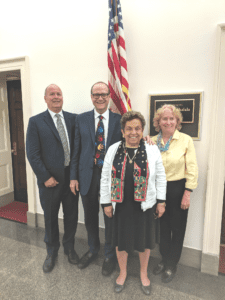On July 10th and 11th, the Dupuytren Research Group went to Washington DC. We visited offices of Congressional representatives and other organizations to raise awareness about the impact of Dupuytren disease and the need for federal funding of Dupuytren research. Right now, there are no federal funds directed specifically for Dupuytren research – not at the NIH, CDC, or DOD.

Over these two days, DRG Board of Directors Laura Holmes Jost, Peter Geimer and I visited over a dozen congressional offices and logged over 10 miles of walking back and forth through the tunnels beneath the Capitol which connect the Senate and House of Representatives buildings.
We met with Democratic and Republican members of Congress. We were well received: Dupuytren is a bipartisan disease. Nearly every office we visited reacted with the same two sentences: “I’ve never heard of this before” and “Why haven’t I heard about this before?“. It was a clear validation of the need to continue with outreach and awareness efforts at all levels of government. We provided materials to all of the offices including pictures and documentation of the impact of Dupuytren disease on individuals, families, and the country. We sought out connections and advice on how to advocate more effectively for federal funding of Dupuytren research.
We provided materials in both short and long versions explaining the need for Dupuytren research.
The materials we gave out included the following, which you might find helpful explaining to others why Dupuytren advocacy is so important and why we need to have honest conversations about the real impact of Dupuytren disease and related conditions:
|
We need to talk about the real impact of Dupuytren disease Dupuytren is a common problem, but advocacy is a challenge because of perception. Most people have a mild version of Dupuytren and for them, it may be a minor concern. At any one time, only one in five people with Dupuytren are ready for a hand procedure. People may have a lump or a slight finger bend as the only issue of their lifetime. Or their fingers aren’t yet bent enough to need straightening. Or they might have one finger affected, have a successful procedure, and never another problem. If everyone fit into that category, there would be no compelling reason to push for better treatment options. But not everyone has mild Dupuytren. Three to five percent of people with Dupuytren – three hundred thousand to half a million Americans – have a treatment-resistant disease which keeps coming back after treatment. Repeat treatments are increasingly riskier and less effective. The chance of a permanent complication goes up with every procedure. For this group, even radical operations are likely to fail over time. Recurrence is the most important problem with Dupuytren because it eventually leads to disabled hands that doctors can’t help. Radical operations may slow recurrence but don’t prevent it. The reality of treatment failure is often missed because individual doctors don’t treat many patients with aggressive Dupuytren. When the surgeon’s perfectly executed state-of-the-art procedure quickly fails because of recurrence, they are baffled, frustrated, and out of optimistic answers. Patients give up. Surgeons give up. This is the group that needs fundamentally different options than what doctors currently have to offer. This is the group that has fallen through the cracks. This is the motivation for our work. The common misperception – doctors and patients alike – is “It’s just a finger – not a real problem.” and the discussion stops. The truth is Dupuytren is a health issue much larger than bent fingers. Several studies have concluded that people with Dupuytren severe enough to require treatment are in fact at greater risk for a variety of other medical problems, cancers, and shortened lives. This isn’t fearmongering. It’s the nature of the disease: Dupuytren is a systemic problem which shows up most obviously in the hands but isn’t confined to them. This is true of many other diseases. Psoriasis, for example, is often seen as a local skin problem. It’s not. Psoriasis is a systemic problem which shows up most obviously as a skin rash, but almost one-third of people with psoriasis will also develop psoriasis-related arthritis and other health issues. This is why aggressive psoriasis is treated with systemic medicines like Enbrel. It was blood test research like we are now doing which led to the development of medicines like Enbrel. People with Dupuytren don’t need a new operation. They need a new medicine to turn off the process at the source, in their bloodstream. We must talk about the fact that Dupuytren is more than bent fingers. It affects overall health. Most surgeons miss this because health-related Dupuytren research is published in medical journals, not surgical journals. Even if a surgeon is aware, it’s off their radar: surgeons don’t dwell on medical problems because they don’t treat medical problems. We must talk about the fact that because Dupuytren affects overall health, Dupuytren care places a large unrecognized financial burden on the federal government, on private insurers, and on individuals. There is hope, but not without difficult conversations about the full impact of Dupuytren. I am very optimistic that this work will transform Dupuytren care, reduce the need for surgery, and lead to healthier lives for those affected. But to do this, to make progress funding and doing research for a cure, we have to have the tough talk: Dupuytren is a major health issue, not just a finger problem. Until more people know this, nothing will change. There’s an even more important reason to talk about Dupuytren-related health issues: research itself. Dupuytren biology is similar to that of other fibrotic medical diseases which have very active research communities: lung fibrosis, liver fibrosis, kidney fibrosis, arteriosclerosis, and others. These diseases are not directly related to Dupuytren, but because of their similarities, fibrosis research benefits Dupuytren research and vice versa. I regularly reach out to researchers in these areas to collaborate because all these fibrotic diseases are – like Dupuytren – local effects of a systemic problem. Their cures need systemic, not local treatments. Dupuytren research may lead to advances in their research. We’re refining research tools honed on these diseases to solve the mystery of Dupuytren. |
Our delegation either connected with or got leads to connect to a variety of government offices whose missions align with the Dupuytren Research Group: the Rare Disease Caucus, Veterans Affairs, FDA, HHS, National Council on Aging, HELP Committee, DOD, NIH, NIAMS Coalition, NIAMS, Senate Special Committee on Aging, House Energy and Commerce Subcommittee on Health, Authorization and Appropriations Committees, and others.
The path is being forged. It’s a daunting task, but based on the experience, I’m more optimistic than ever that our efforts will we will bring about much-needed government support for research to find a cure for Dupuytren disease and related conditions.
Charles Eaton MD






